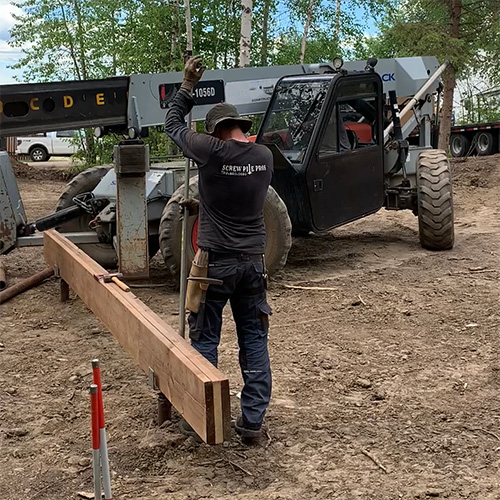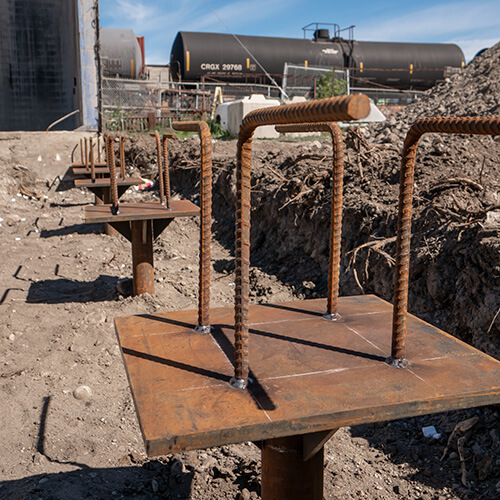Screw Pile Lifespan
The lifespan of helical screw piles can vary depending on various factors, such as the soil conditions, the size and type of the pile, and the pile material. In general, certified helical screw piles are designed to provide long-term structural support and can last from 50 to 75 years, depending on soil conditions.
National Research Council and the Minimum 50 year life requirement
Having CCMC-conforming screw piles installed by an approved installer is critical to the life of your screw pile foundation. CCMC manufacturers are required to fabricate steel screw piles from only new material, and the overall structural (mechanical) capacity of their products has to be calculated considering their reduced thickness from corrosion to meet a minimum service life of 50 years. These requirements made by the National Research Council of Canada ensure that a helical pile foundation will maintain its structural integrity and meet the minimum 50-year lifespan.
The Calgary Screw Pile Pros are approved by the manufacturer of CCMC screw piles to provide screw pile foundations that conform to the requirements of the NRC. Choose a helical pile foundation from the Calgary Screw Pile Pros to ensure a safe, durable, and long-lasting foundation for your construction project.


Corrosion is the greatest threat to screw pile longevity
The greatest factor in the longevity of helical screw piles is corrosion caused by the soil conditions in which they are installed. The soil’s properties and characteristics, such as its type, moisture content, and density, all have a significant impact on its corrosiveness.
For example, if the soil is acidic or saline, it can cause corrosion and deterioration of the screw pile material over time. If screw piles are left without corrosion controls, this can lead to a reduced load capacity and structural integrity of the pile, which can ultimately result in failure. This is why using CCMC screw piles with corrosion management factored into their design like that of CCMC piles is essential.
What is the best way to manage corrosion in screw piles?
To conform to the CCMC requirements screw piles must be designed to resist corrosion or compensate for the structural loss caused by corrosion overtime. There are several ways to manage corrosion in screw piles.
Having the right material for the screw pile is an important first step in managing corrosion. Materials such as new non-recycled steel (required by CCMC) or stainless steel have a higher resistance to corrosion and can help prolong the life of the pile. However, due to their very high cost, it is very rare that stainless steel screw piles are ever used.
Another method of corrosion control is to apply protective coatings to the screw pile, which can also help prevent corrosion. Common coatings include epoxy coatings, polyurethane coatings, or other specialised coatings that are designed for corrosive environments. The drawback to this method is that the quality of corrosion prevention is limited to the bond between the steel and the coating. As coatings can sometimes lift from the steel, they can allow moisture to penetrate and cause corrosion to occur. Also, the use of epoxy coatings adds an environmental hazard that should be considered.
Hot Dip Galvanising is a sacrificial coating used to prevent the corrosion of helical piers. Galvanising is the process of applying a protective zinc coating to steel or iron to prevent corrosion as the zinc coating becomes a sacrficial layer. Zinc is a highly reactive metal, so it corrodes preferentially to steel, effectively sacrificing itself to protect the steel underneath.
Not unlike the chemical coatings. The hot-dip galvanising process has some negative environmental impacts because of the toxic chemicals needed for the zinc coating process to work. Sodium hydroxide, hydrochloric acid, and zinc ammonium chloride are just some industrial chemicals needed to coat steel screw piles with a galvanized coating. The production and disposal of chemicals such as these need to be taken into consideration due to their potential danger to organic material and living things.
The Most Cost Effective & Environmentally Friendly Means of Corrosion Management
In most things, the simplest method is usually the best. As specified by CCMC simply making helical screw piles out of thicker steel than what is needed for structural purposes, a sacrificial amount of steel is available to rust away before the pile begins to lose any structural integrity.
For example, the engineer for your Calgary construction project determines that a screw pile shaft of 1/4″ in thickness is needed to support the load of your structure. So, if the screw pile shaft is instead made from 3/8″ steel, there is an additional 1/8″ of material that will take considerable time to corrode away before the structural portion of the pile’s material is even affected. This is referred to as sacrificial material. In the case of black steel screw piles in Calgary soil conditions, it can take in excess of 50-70 years for that sacrificial material to corrode and allow the structural integrity of the pile to degrade.
Overall, using a thicker material with an added amount of sacrificial material is a way more cost-effective and environmentally friendly way to manage corrosion in screw piles.
Safe, Long Lasting, & Environmentally Friendly Helical Piles in Calgary
For many years, the Calgary Screw Pile Pros have provided long-lasting screw pile foundations in and around the city of Calgary. Rest assured that a Screw Pile Pros helical pile installation conforms to the requirements set out by the NRC and is compliant with the Alberta Building Code. If you wish to learn more about using CCMC-engineered screw piles for your next project, please do not hesitate to contact the Calgary Screw Pile Pros.
